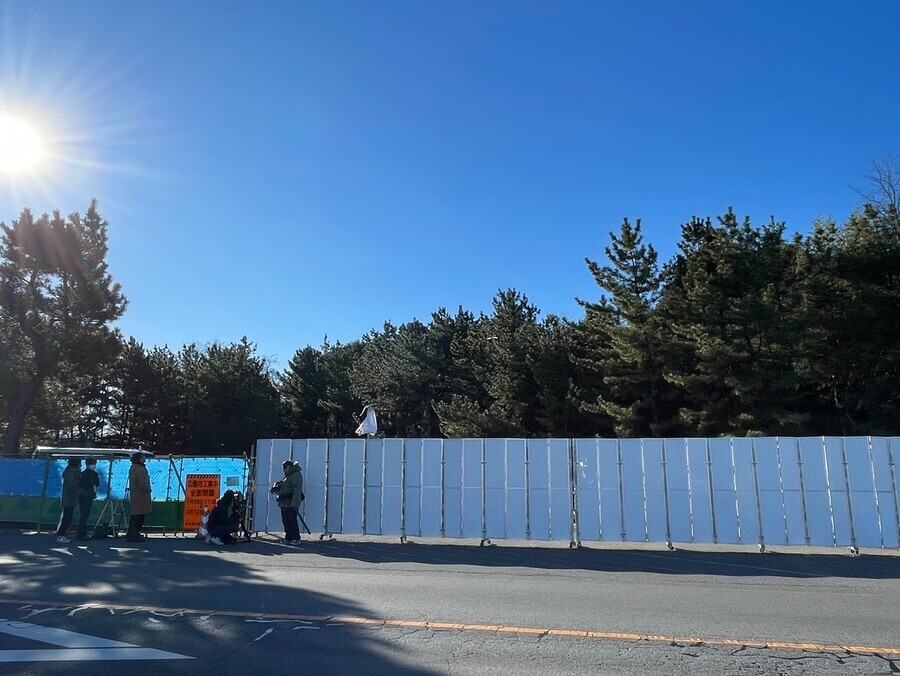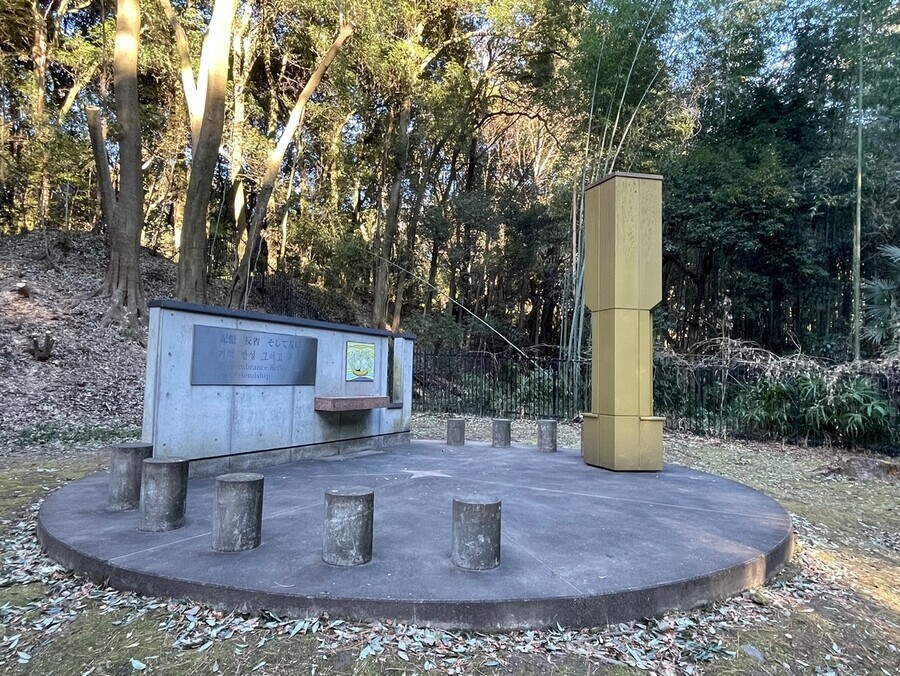hankyoreh
Links to other country sites 다른 나라 사이트 링크
[Reportage] Yoon sits idly by as Japan tears down memorial to Korean forced laborers

Visitors to the Gunma Prefectural Forest Park in Takasaki, Japan, on Monday morning were greeted by a massive 2-meter-high, 20-meter-long screen blocking the rear entrance to the park. Next to it extended a new chain-link fence bordering the park. It looks like a desperate attempt by the local government to ward off press and residents while they remove a memorial to Korean victims of forced labor during the Japanese occupation of Korea.
When the removal began, a few reporters from Korean and Japanese outlets arrived on the scene, but the barricade prevented them from entering or even viewing the premises. One reporter from a Japanese broadcaster remarked, “We requested permission to cover the removal, but it was of no use.” Cranes and other heavy equipment for removing the memorial were brought in under cover of night.
After such thorough preparations, the local government proceeded to remove this symbol of friendly relations between South Korea and Japan for the past 20 years. The memorial is formed by a round stone base 7.2 meters in diameter, on which rests a stone 1.95 meters tall and 4.5 meters wide, which is topped with a gold tower 4 meters tall. Once accessible after a three-minute walk from the park’s rear entrance, the memorial is now off limits, and will soon be removed without a trace. The demolition will take place over two weeks, until Feb. 11. During that period, even the city bus won’t stop at the park.

“Even the local government knows what it’s doing is shameful. Why else would they be removing it under wraps?” said Yasuhito Fujii, 74, the executive director of the activist group that installed and maintained the memorial, which bears the phrase: “Remembrance, Reflection and Friendship.”
“Removing the memorial is an attempt to erase Japan’s history of wrongdoing. Even if the memorial is removed, the spirit of remembrance, reflection and friendship with Koreans will live on,” he said.
Japanese civic society has expressed vehement opposition to the monument’s removal. On Sunday, the day before the removal began, hundreds of people from all over Japan gathered in front of the memorial to protest its removal, some even camping out all night. The protesters declared, “Removing the memorial will only add to the historical denial of far-right groups that claim that Koreans weren’t forced into labor.” Over 4,300 Japanese artists signed a petition opposing the removal, which was submitted to the prefectural government on Friday.

Posts with hashtags opposing the removal of the monument in Gunma are abounding on social media.
“Gov. Ichita Yamamoto keeps saying we need more Korean-Japan exchange and tourism, yet he is spearheading the removal of a memorial that symbolizes friendly relations. Such hypocritical behavior,” posted Yusuke Ueda, who works as a translator.
“Residents are continuing to send messages opposing the removal via email and fax,” Ueda added.
Efforts to remove the memorial first gathered steam in 2014, when former Prime Minister Shinzo Abe returned to politics, giving rise to a new wave of far-right ideology. The group that erected the monument in Gunma regularly held memorial ceremonies there honoring the victims of forced mobilization from 2004 to 2012. Far-right groups bristled at the term “forced conscription,” and began offering their counter-response. Gunma Prefecture interpreted the ensuing controversy as an opportunity to live up to its promise of “not allowing or partaking in politically controversial events.”
The following July, the local government denied an extension of the permit that allowed the memorial to remain in the park. The group that put the monument there responded through legal action. The activists won the initial trial in April 2018, but Gunma Prefecture proved victorious in the appeal in June 2022. The prefectural government ordered the removal of the memorial in April 2023. When local activists refused to comply, the government utilized its administrative authority to push through.
By Kim So-youn, Tokyo correspondent
Please direct questions or comments to [english@hani.co.kr]

Editorial・opinion
![[Editorial] Penalties for airing allegations against Korea’s first lady endanger free press [Editorial] Penalties for airing allegations against Korea’s first lady endanger free press](https://flexible.img.hani.co.kr/flexible/normal/500/300/imgdb/original/2024/0502/1817146398095106.jpg) [Editorial] Penalties for airing allegations against Korea’s first lady endanger free press
[Editorial] Penalties for airing allegations against Korea’s first lady endanger free press![[Editorial] Yoon must halt procurement of SM-3 interceptor missiles [Editorial] Yoon must halt procurement of SM-3 interceptor missiles](https://flexible.img.hani.co.kr/flexible/normal/500/300/imgdb/child/2024/0501/17145495551605_1717145495195344.jpg) [Editorial] Yoon must halt procurement of SM-3 interceptor missiles
[Editorial] Yoon must halt procurement of SM-3 interceptor missiles- [Guest essay] Maybe Korea’s rapid population decline is an opportunity, not a crisis
- [Column] Can Yoon steer diplomacy with Russia, China back on track?
- [Column] Season 2 of special prosecutor probe may be coming to Korea soon
- [Column] Park Geun-hye déjà vu in Yoon Suk-yeol
- [Editorial] New weight of N. Korea’s nuclear threats makes dialogue all the more urgent
- [Guest essay] The real reason Korea’s new right wants to dub Rhee a founding father
- [Column] ‘Choson’: Is it time we start referring to N. Korea in its own terms?
- [Editorial] Japan’s rewriting of history with Korea has gone too far
Most viewed articles
- 160% of young Koreans see no need to have kids after marriage
- 2Presidential office warns of veto in response to opposition passing special counsel probe act
- 3Japan says it’s not pressuring Naver to sell Line, but Korean insiders say otherwise
- 4Months and months of overdue wages are pushing migrant workers in Korea into debt
- 5[Reporter’s notebook] In Min’s world, she’s the artist — and NewJeans is her art
- 6[Editorial] Penalties for airing allegations against Korea’s first lady endanger free press
- 7OECD upgrades Korea’s growth forecast from 2.2% to 2.6%
- 8At heart of West’s handwringing over Chinese ‘overcapacity,’ a battle to lead key future industries
- 9Hybe-Ador dispute shines light on pervasive issues behind K-pop’s tidy facade
- 10Inside the law for a special counsel probe over a Korean Marine’s death